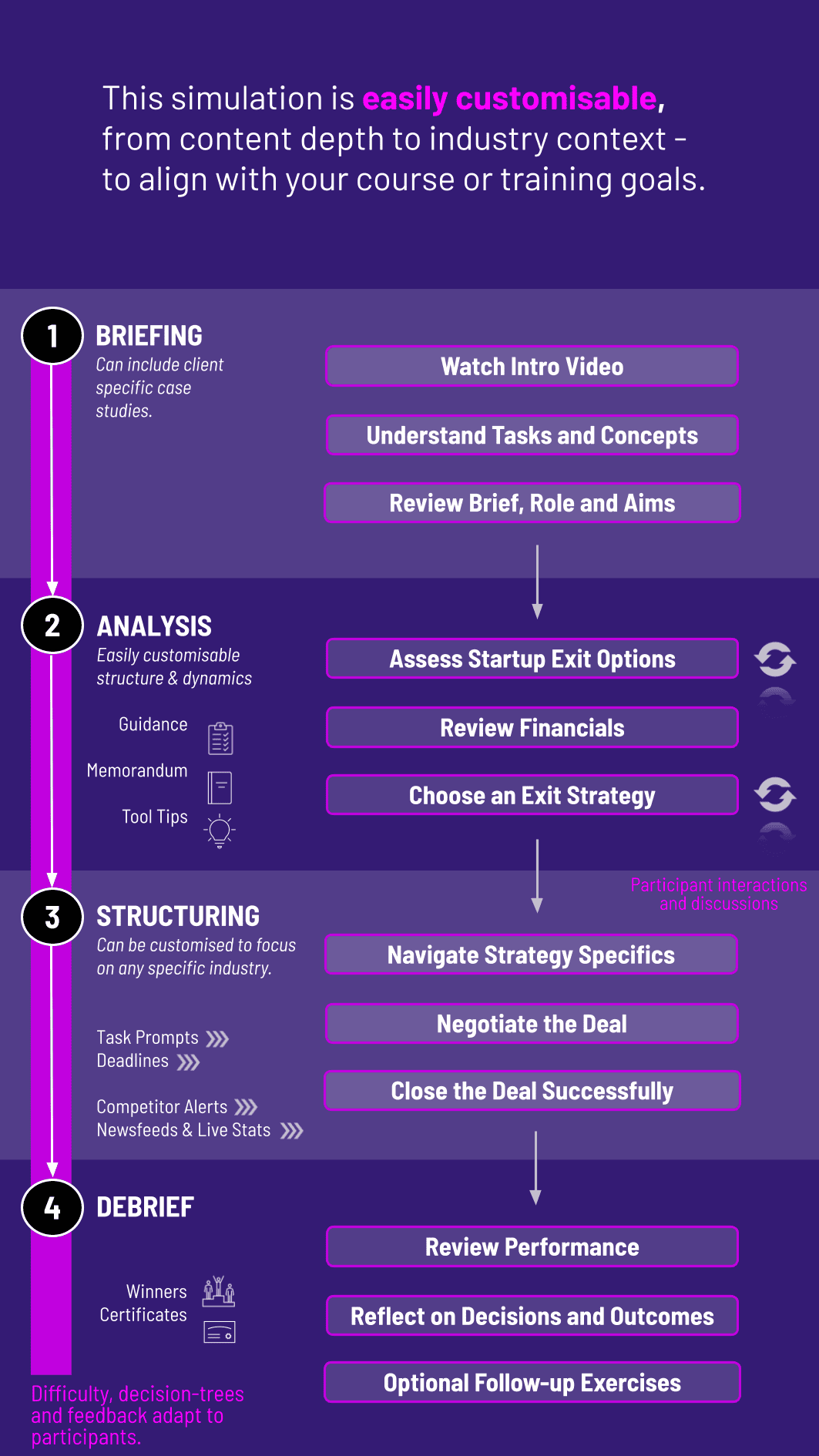
In this hands-on Startup Exit Strategy Simulation, participants act as founders and investors navigating acquisition, IPO, or merger paths - balancing valuation, timing, negotiation, and stakeholder expectations under uncertainty.
Exit strategy evaluation: IPO, M&A, secondary sales
Valuation drivers and market timing
Investor and founder alignment
Negotiation tactics in high-stakes deals
Stakeholder management: boards, employees, acquirers, and regulators
Legal and compliance considerations in exits
Trade-offs between liquidity, control, and growth
Communication strategy during exit planning
Role of market cycles and investor sentiment
Long-term strategic positioning post-exit


Analyze financial performance and market comparables
Debate IPO vs acquisition strategies under changing conditions
Negotiate term sheets and deal structures
Manage competing stakeholder interests (founders, employees, VCs)
Respond to regulatory, legal, or reputational challenges
Communicate decisions through board presentations, press releases, or investor memos
By the end of the simulation, participants will be able to:
Evaluate the advantages and risks of different exit strategies
Understand valuation mechanics and timing implications
Balance stakeholder objectives in exit negotiations
Apply negotiation frameworks in high-pressure deal environments
Communicate effectively with boards, employees, and investors
Recognize legal and compliance issues in exit planning
Anticipate post-exit strategic and cultural challenges
Adapt strategy in response to market signals
Collaborate across founder, investor, and management perspectives
Build resilience in decision-making under uncertainty
The simulation’s flexible structure ensures that these objectives can be calibrated to match the depth, duration, and focus areas of each program, whether in higher education or corporate learning.
The simulation works equally well in academic or corporate contexts and can run individually or in teams. Each cycle reflects a stage of the exit process.
1. Receive a Scenario or Brief: Participants are given a startup profile, investor dynamics, and exit options. The scenario sets objectives and context for decision-making.
2. Analyze the Situation: They review financials, market conditions, competitor exits, and regulatory landscapes to frame their choices.
3. Make Strategic Decisions: Participants decide whether to pursue an IPO, acquisition, or merger, and negotiate terms, valuation, and timing.
4. Collaborate or Negotiate: Teams role-play as founders, VCs, or acquirers - balancing perspectives and debating trade-offs.
5. Review Results and Reflect: Feedback reveals valuation outcomes, stakeholder sentiment, and reputational effects. Participants reflect on both quantitative and qualitative outcomes.
6. Iterate and Advance: Subsequent rounds introduce new shocks - market downturns, rival offers, or regulatory changes—forcing participants to adapt strategies.
Do participants need prior startup experience? No. The simulation is designed to be accessible but challenging for all levels.
What exit paths are included? IPO, M&A, secondary sales, and strategic mergers can all be explored.
Can the simulation reflect specific industries? Yes. It can be tailored to reflect tech, fintech, consumer, or healthcare contexts.
Is there a negotiation element? Yes. Participants negotiate term sheets, deal structures, and valuations with stakeholders.
Can it be run in teams? Yes. Teams can take on founder, investor, and acquirer roles to mirror real-world dynamics.
How long does it run? It can be a short 2-hour exercise or extended into multi-day sessions.
Does it cover cultural or post-exit issues? Yes. Scenarios include employee morale, cultural integration, and leadership changes post-exit.
Can universities use it in entrepreneurship courses? Absolutely. It fits seamlessly into entrepreneurship, venture capital, and strategy programs.
How is success measured? By valuation outcomes, stakeholder alignment, and post-exit strategic sustainability.
Is it suitable for corporate training? Yes. It’s highly relevant for innovation teams, corporate venture units, and intrapreneurs.
Quality of exit strategy evaluation and justification
Valuation outcomes and timing decisions
Effectiveness in negotiations and stakeholder alignment
Communication clarity in investor or board updates
Responsiveness to market shocks and new information
Peer/self-assessments for collaboration and leadership
You can also include memo writing and debrief presentations as part of the assessment structure. Additionally, you can also add a built-in peer and self-assessment tool to see how participants rate themselves. This flexibility allows the simulation to be easily integrated by professors as graded courses at universities and by HR at assessment centres at companies.
Join this 20-minute webinar, followed by a Q&A session, to immerse yourself in the simulation.
or
Book a 15-minute Zoom demo with one of our experts to explore how the simulation can benefit you.